Brassica carinata, sometimes called Ethiopian mustard, Abyssinian mustard, or simply carinata, is an annual oilseed crop used for the commercial production of jet fuel. It is similar to canola in growth habit. Carinata by-products include seed meal for animal feed (Agrisoma 2017) and sinapic acid for organic and polymer synthesis (Shen 2019), and the residue may act as a bio-suppressant against nematodes (Oka 2010). It is grown during the winter in the southeastern United States and may have potential as an alternative winter crop for the region.
One of the challenges to commercialization of this crop in the region has been freeze damage. Since the crop is planted in late fall, temperatures can sometimes fluctuate between 50°F (10°C) during the day to 20°F (-6.7°C) that same night as a front moves through, giving the crop little time to harden off. Susceptibility to freeze damage depends on temperature, duration at a given temperature, crop growth stage, and nitrogen application rates. Genotype screening trials throughout the Southeast are underway to identify freeze-tolerant cultivars.
This publication serves as a guide to assess freeze damage and discuss management issues related to freeze damage of carinata in the southeastern United States for growers, Extension agents, researchers, crop consultants, and agricultural professionals. Be aware that this is a relatively new crop to the Southeast and research on this topic is ongoing. This publication represents the latest information available. More information about carinata production in Florida is available from Seepaul et al. (2019) at https://edis.ifas.ufl.edu/publication/AG389.
Symptomology
The severity of freeze damage largely depends on the crop stage. At the seedling stage when roots are shallow and there are few carbohydrate reserves, freeze can kill the crop. At the rosette stage, leaves protect the growing point and roots are deeper, resulting in greater freeze tolerance, although leaf tissue damage can occur. After bolting, the stalk and growing points are most susceptible to freeze damage. Stalk damage typically results in tissue damage several inches above the soil surface, where structural stresses are high. Death of the growing point commonly results in new shoot growth from the crown of the plant or from just below the damaged tissue after bolting.
Minor freeze damage first appears as wilting. Within about one week, symptoms present as bleaching of the leaves, particularly near the tips and leaf margins (Figure 1). If freeze damage is more severe, these areas may become necrotic, but the crop is expected to outgrow this level of damage with minimal yield loss (Figure 2).
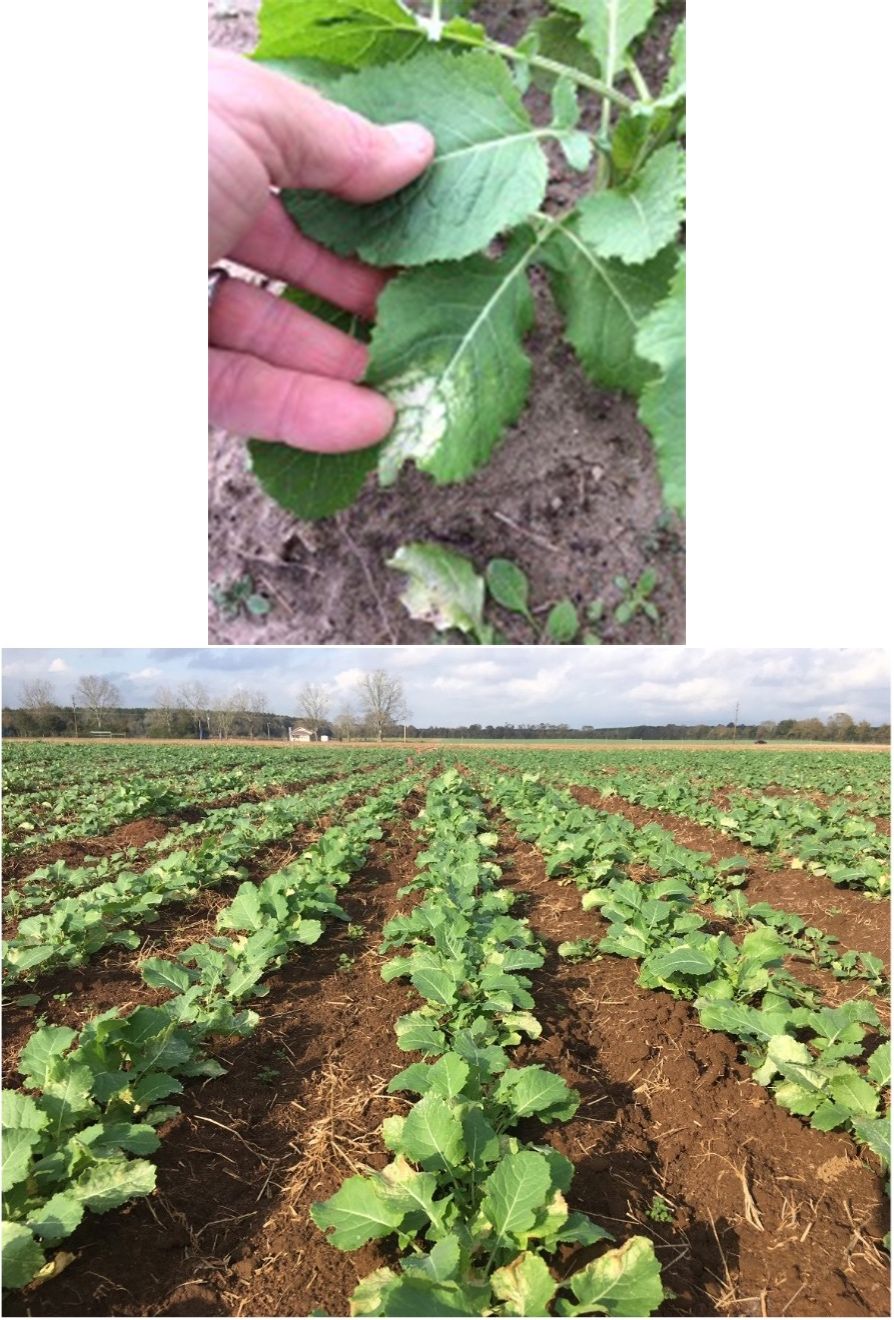
Credit: M. J. Mulvaney, UF/IFAS
Table 1. Cumulative hours below temperature thresholds four weeks prior to the date the photos in Figure 1 were taken.
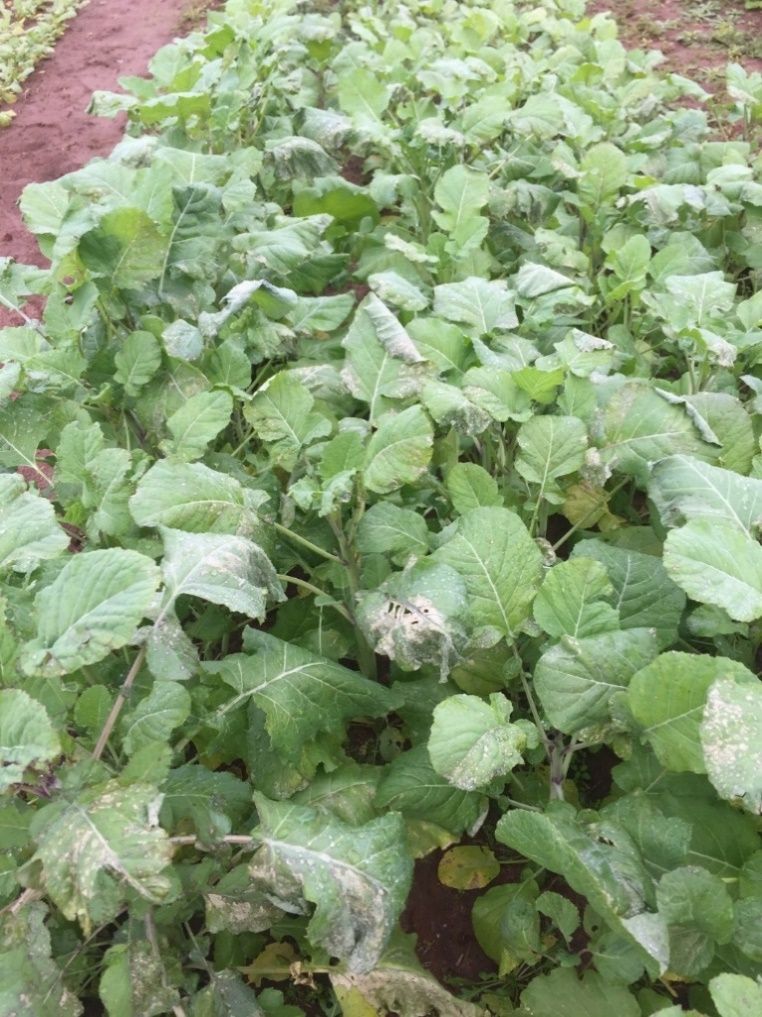
Credit: M. J. Mulvaney, UF/IFAS
Table 2. Cumulative hours below temperature threshold four weeks prior to the date the photo in Figure 2 was taken.
Figure 3 shows severe cold damage. This level of damage is expected to reduce crop stands and yield. Note that the aboveground tissue was severely affected, but the roots did not die. The plants in Figure 3 grew back from the growing point, but can also be expected to resprout from the crown if the roots did not freeze. Replanting of this field is not recommended due to lateness and expected continued crop growth.

Credit: M. J. Mulvaney, UF/IFAS
Table 3. Cumulative hours below temperature thresholds four weeks prior to the date the photo in Figure 3 was taken.
After bolting, freeze damage of the stalk is more problematic (Figure 4). Splitting of the stem may be evident several inches off the ground, but the stalk can freeze without splitting, effectively clogging the vascular tissue later in the season and presenting as a wilted appearance. When this happens, the stem can hollow out at the point of damage. The weakened stem often results in lodging, although some plants will frequently right themselves, giving a “J-stemmed” appearance (Figure 5). The injured stem can serve as an entry point for pests, such as Sclerotinia (leading to Sclerotinia stem rot) and yellowmargined leaf beetles (Microtheca ochroloma Stål) (Figure 6).
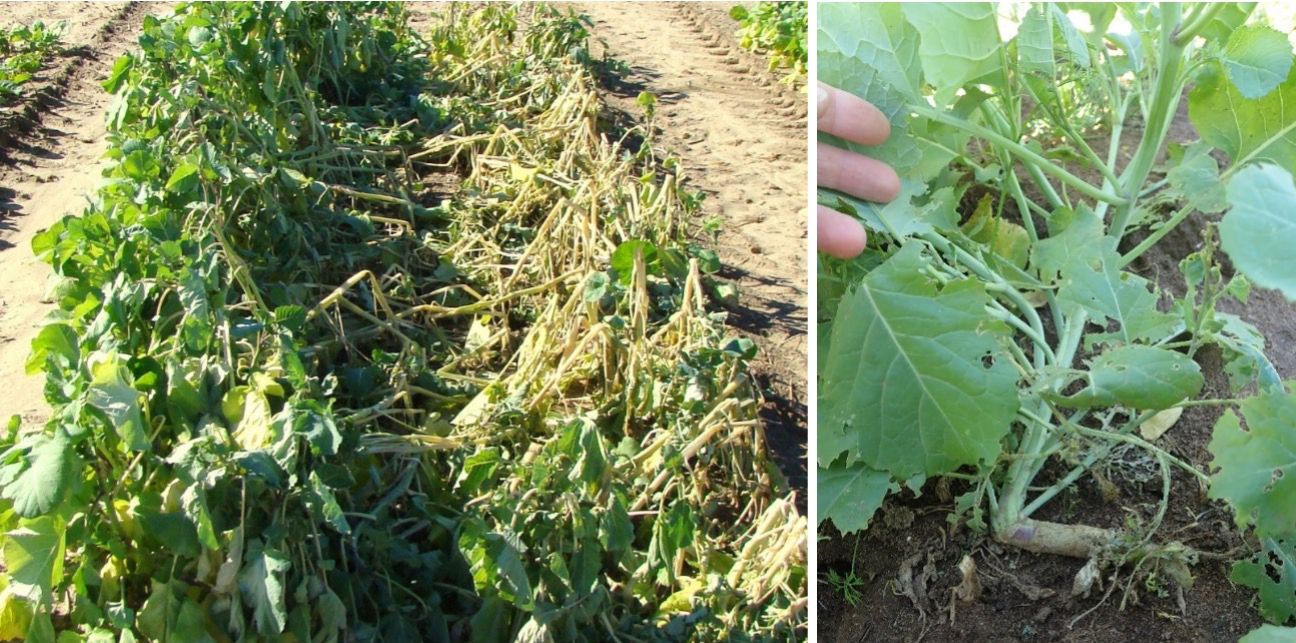
Credit: Left: R. Seepaul, UF/IFAS. Right: M. J. Mulvaney, UF/IFAS
Table 4. Cumulative hours below temperature thresholds four weeks prior to the date the left photo in Figure 4 was taken.

Credit: Left: M. J. Mulvaney, UF/IFAS. Right: P. L. Phillips, UF/IFAS

Credit: M. J. Mulvaney, UF/IFAS
Freeze damage during pod fill is problematic due to poor seed set and pod abortion. This may cause undeveloped seeds and empty pods, leading to severe crop losses. A crop that has suffered freeze damage during pod fill may resprout from the crown. A field suffering this level of damage may be considered a complete loss.
While freeze damage can be severe, carinata has shown impressive resiliency. Growers in northwest Florida jokingly call this “the Lazarus crop” because of its ability to apparently come back from the dead. The same plot after a hard freeze is shown in Figure 7, where about 25% of the plants suffered mortality. As a highly plastic crop, carinata can promote branching, pod formation, and leaf area to compensate for stand loss, but there is evidence that secondary branches are not as productive as primary branches. It is also important to note that prolonged freeze duration at bolting can weaken carinata stems. This can lead to heavy damage later during the season (at pod fill) as the plant struggles to support heavy growth at the top which can ultimately result in yield loss (Figure 8).
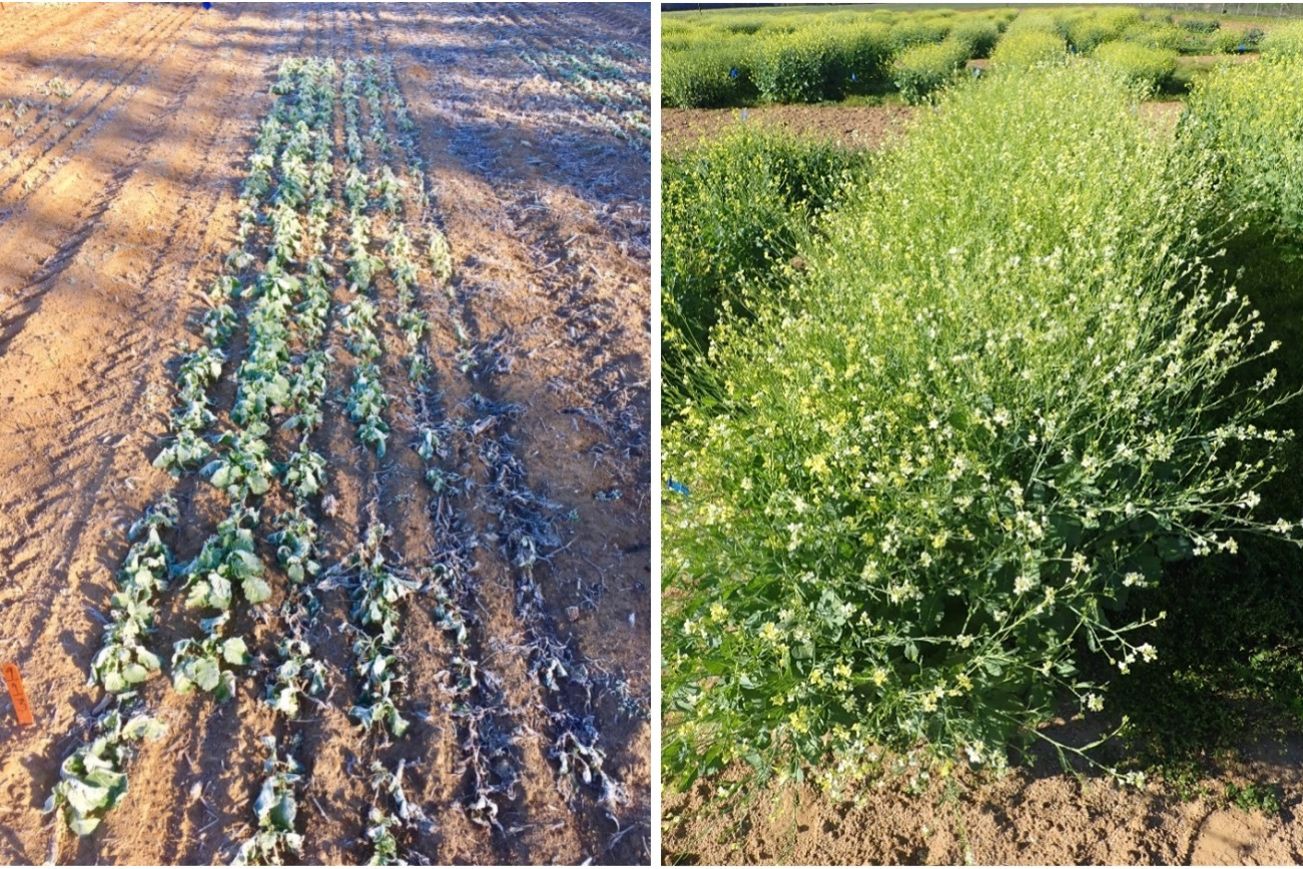
Credit: Left: M. Brown, UF/IFAS. Right: M. J. Mulvaney, UF/IFAS
Table 5. Cumulative hours below temperature thresholds four weeks prior to the date the left photo in Figure 7 was taken.
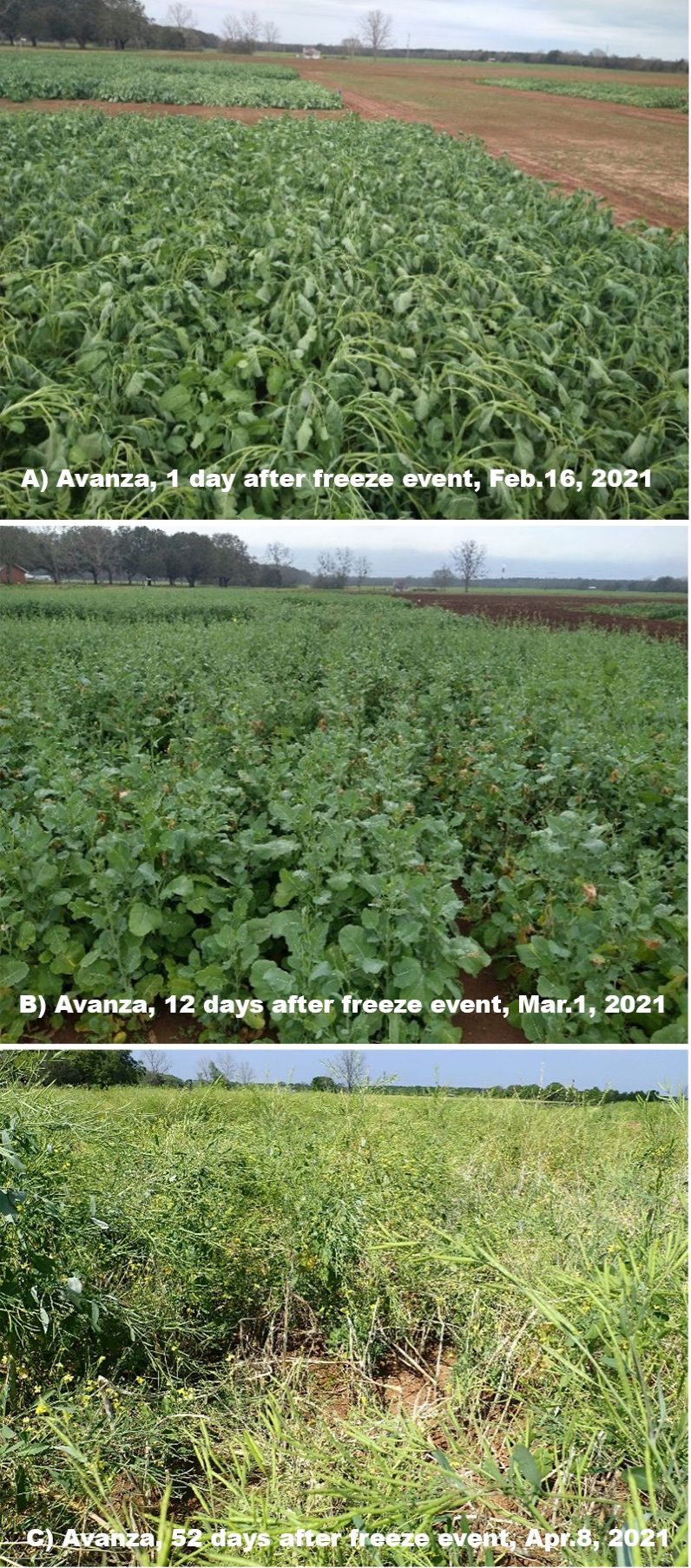
Credit: M. Bashyal, UF/IFAS
Table 6. Cumulative hours below temperature thresholds 12 days prior to the date the middle photo (B) in Figure 8 was taken.
How to Minimize Risk of Freeze Damage of Carinata
- A general recommendation is that carinata should be sown approximately six weeks before first frost.
- In the Florida Panhandle, plant carinata during the first two weeks of November. In North Carolina, planting should occur between mid-September and early October. Earlier plantings will reduce yield, and later plantings are more likely to result in small plants at the seedling stage with shallow roots during freeze events. Plants at this stage are more susceptible to freeze damage and may require replanting if the roots freeze. Timely planting allows plants to develop into the rosette stage, when freeze tolerance is greater, during times when the probability of freeze is highest.
- Do not over-apply early-season nitrogen (N). Excessive N promotes luxuriant growth that is more susceptible to freeze damage. Limit at-plant N applications to 20 lb N/ac or lower. Preliminary results indicate greater freeze damage under higher rates of applied N (Figure 9). Calibrate your spreader so you do not over-apply. Topdress N applications are typically made at early bolting.
Be advised that this is a relatively new crop to the Southeast. Ongoing research and new information will change production recommendations. Additionally, promising new carinata varieties with improved freeze tolerance and yield gains are being developed from the breeding program for commercial production (Figure 10). Check with your local Extension agent for the latest production information.
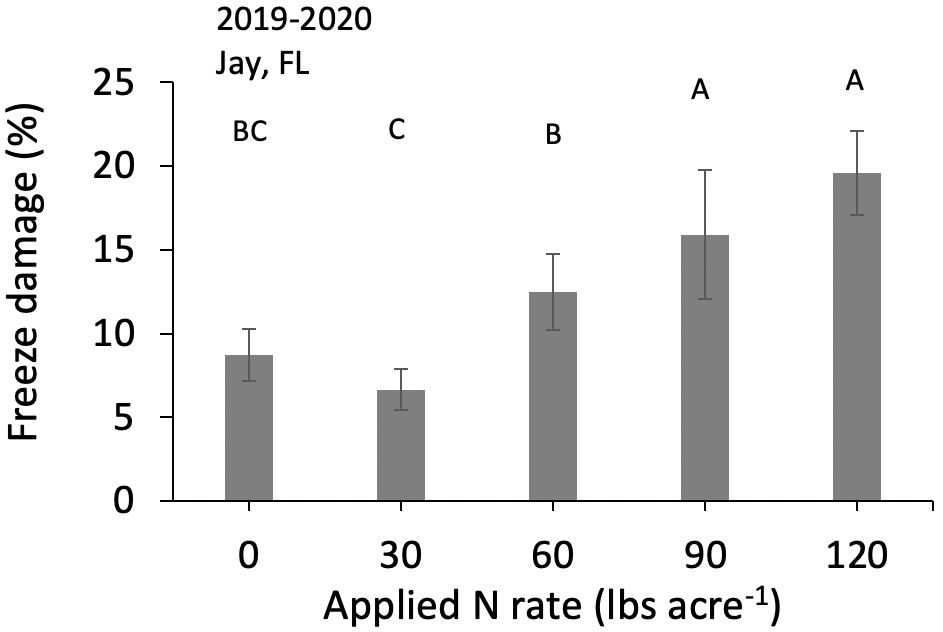
Credit: M. Bashyal, UF/IFAS
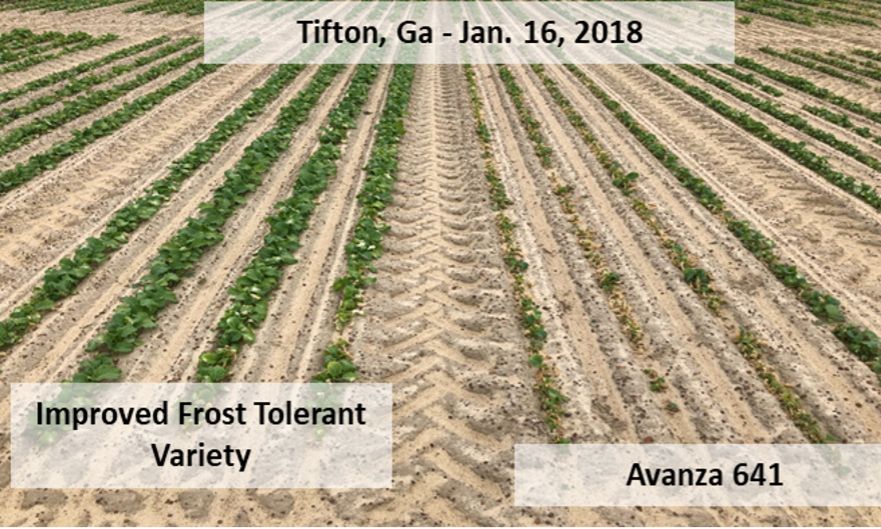
Credit: Nuseed Co. (previously Agrisoma Biosciences Inc.)
References
Agrisoma. 2017. Southeastern US 2017–18 Carinata Management Handbook. https://agrisoma.com/wp-content/uploads/2018/10/2017_18_SE_Handbook.pdf
Oka, Y. 2010. "Mechanisms of Nematode Suppression by Organic Soil Amendments—A Review." Applied Soil Ecology 44:101–115. https://doi.org/10.1016/j.apsoil.2009.11.003
Seepaul, R., I. M. Small, M. J. Mulvaney, S. George, R. G. Leon, S. V. Paula-Moraes, D. Geller, J. J. Marois, and D. L. Wright. 2019. Carinata, the Sustainable Crop for a Bio-Based Economy: 2018–2019 Production Recommendations for the Southeastern United States. SS-AGR-384. Gainesville: University of Florida Institute of Food and Agricultural Sciences. https://edis.ifas.ufl.edu/ag389
Shen, S. 2019. “Extraction and Polymerization of Bio-Aromatics from Megacrops.” MSc thesis. Gainesville: University of Florida. https://ufdc.ufl.edu/UFE0055730/00001
